-
Crazy Pot Salad

- Mixed greens plus blossoms, herbs and tiny potatoes
Crazy Pot Salad is what my daughter calls a main dish I make because it involves many different ingredients that vary as to availability. It always turns out great, though, which is truly amazing. It is a greens salad that also has cooked items and a balance of flavors, textures and colors that make every forkful slightly different. It involves both cold and hot ingredients, all thrown into the same bowl and mixed together to create a melded warm dinner that is as healthful as it is delicious. It is even good as cold leftovers the next day.
Tonight’s salad was born of the need to eat the mixed salad greens that were overgrowing in the garden. I cut and picked various greens and started from there. To create a Crazy Pot Salad, I keep in mind these components:
Fresh Greens: the more varied the better. Fresh herbs such as dill, basil, chives and cilantro, along with arugula and a lettuce mix, work well. Don’t forget some iceberg for crunch. If you don’t have or want to use iceberg (a much maligned vegetable) then cut up fresh celery.

- A mix of colors and textures is essential
Protein: Tofu, soy chicken strips (such as Morningstar Farms), soy bacon, soy tuna, etc. Beans such as garbanzo or Northern white work well. Using a couple types of proteins are tastier and more nutritious. Cook the protein and use hot.
Starch: Pasta in small shapes, rice, or a cooked grain such as quinoa. Use the starch hot.

- Quinoa (pronounced keen-wa) is high in Omega-3.
Other additions: diced carrots, steamed tiny potatoes or potato chunks (hot), feta or cotija cheese (crumbly), marigold petals, nasturtium blossoms, squash blossoms, capers, heart of palm, mushrooms, pea pods, avocados, green beans fresh or cooked… whatever you have that you need to use. Look for colors to add. I can’t stand Bell peppers, but that is usually the go-to choice when people want to add color to anything. You can avoid the Bell pepper taste-takeover of your salad if you want with a little creativity. Stir-fry up some chopped red cabbage and throw it in with some raw carrots.
Crunch: Nuts, such as pignoli (pine), cashews, sunflower seeds or almonds. Toast them in a little olive oil or in the toaster oven to bring out their flavor.
Dressing: This salad just about makes its own dressing. I like to make Italian dressing with a packet of Lowry’s Italian dressing mix, using red wine vinegar and olive oil. Or I make the dressing as I cook, which I’ll include in the recipe. The cooked shiitake mushroom gives the olive oil a deep, savory note and adds a very interesting flavor and texture. Along with the pignoli nuts, chives and crumbled soy bacon, this makes a delicious subtle dressing that is mixed into the salad rather than adorned on the top. The hot starch, including the potatoes, will readily absorb the hot flavored olive oil.

- Shiitake mushrooms, pignoli nuts and soy bacon dressing
Remember, this is a salad of opportunity; use what you have and what you love, but keep in mind the different components, the shapes and colors of the ingredients, the texture and nutritional value. Bland foods such as the potato will balance strongly flavored ones such as arugula.

- Yum. Just: yum!
Crazy Pot SaladAuthor: Diane C. KennedyRecipe type: Main Dish SaladPrep time:Cook time:Total time:Serves: FourThis warm combination of greens and other ingredients make a balanced, delicious healthy main dish that can change with what you have available.Ingredients- One cup quinoa, prepared with vegetable broth following box directions
- Four cups (approx.) mixed fresh greens washed and torn into bite-sized pieces
- Two sprigs each fresh dill, basil, chives and cilantro, chopped
- One cup torn iceberg lettuce
- Three calendula flowers and four squash flowers, torn into small pieces (just petals)
- Eight very small potatoes
- Cotija cheese (or veggie substitute. Dairy can be optional)
- Half an 8-oz can garbanzo beans
- Two small carrots, sliced into discs
- One tomato, diced
- A tablespoon olive oil (flavored, if you have it)
- One package Morningstar Farms Chicken Strips
- For Dressing:
- Six fresh shiitake mushrooms
- Four strips Morningstar Farms soy Bacon Strips
- Three tablespoons pignoli nuts
- ⅛th cup olive oil
Instructions- Prepare quinoa in medium saucepan using vegetable broth, according to the instructions on the box.
- Steam small potatos until tender
- Meanwhile, wash, dry and tear up fresh greens, herbs, iceberg and flowers. Put in large bowl.
- Crumble about four tablespoons Cotija cheese over greens in bowl.
- Add garbanzo beans
- Add carrot discs
- In frying pan, heat a tablespoon of olive oil and stir-fry the soy chicken strips until browned (if you have flavored olive oil, such as citrus or basil, use that to cook these).
- Add hot soy chicken strips to bowl.
- In same frying pan, heat ⅛th cup olive oil on medium high.
- Chop shiitake mushrooms and add to frying pan.
- Cook mushrooms on medium-high heat until they are almost crunchy.
- Add soy bacon strips and pignoli nuts.
- Stir nuts until they are browned (watch so they don't burn).
- Flip bacon and remove when browned.
- Pour contents of pan on mixture in bowl.
- Crumble bacon strips and add to bowl.
- Add steamed potatoes, quartered to bowl.
- Add quinoa to bowl.
- Toss contents of bowl until well mixed. Heavy ingredients will sink to the bottom, so be sure to mix well.
- Plate the salad and garnish with chopped tomatos and more cheese, if using.
-
Answers

Drinking the Small Pond Down I really haven’t been avoiding blogging. I’ve tried to do it, but I’ve just been exhausted in the evening, which is my usual writing time, and haven’t stayed awake long enough to finish writing. Obviously we’ve made it back to Fallbrook, pulling in about 9 pm on Saturday. Many things happened during my five days gone. As I am about to frost a Buttermilk Chocolate Ganache Cake (see recipes!) (I occasionally sell baked goods) that will be picked up at 7 am tomorrow, I’ll provide answers to the questions I posed before leaving on my Oregon Or Bust sojourn.
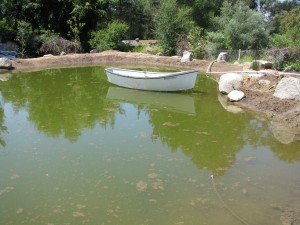
A Full Pond! Yes, the pond was filled! Gloriously full, and with a boat blowing from shore to shore in the breeze! The boat is on loan from Aquascape, who uses it in their work, but put out to float just to show off the pond for my return. Water plants are being transplanted and seeded around the ‘wicking’ areas, and the streambed area for rain is being sculpted. I’m not the only one who enjoys the pond!
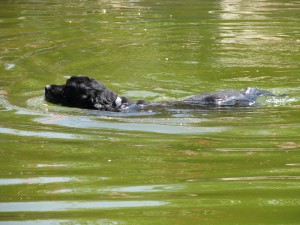
If he thinks he can sleep on the couch after this....! The palm trunks are being made into a bridge, which isn’t quite finished yet.

Bridge to Be The cement stairs now have posts for a walk-through arbor.

Gateway to the Garden The gnawed-upon palm stairs are even more gnawed-upon, but there are piles of bunny poo left where the culprits spent plenty of time wearing down their ever-growing teeth! The Bitter Apple didn’t seem to make a difference when I sprayed it on the steps. I’ll need to try garlic next.

Bunny Poo As for my veggie garden, the pumpkin and watermelon have grown at least two feet in a week, and the pickling cucumbers have outgrown the two lengths of support twine that I put up above their heads just before leaving!
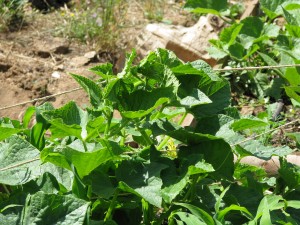
Vigorous Cukes I’ve added more and guided them up. All the plants not only survived, but they thrived. I so cannot wait for the taste of my own first of the season tomato!
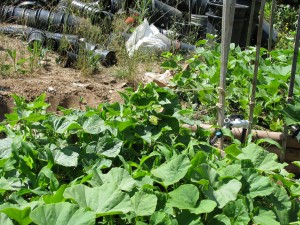
Happy Vines I still have a question, though. Why is it that a roadside stand in Oregon sells avocados for .35 cents apiece, when back home – in the Avocado Capital of the US – they sell for $1.45 apiece in the grocery store? And they aren’t very nice, either! You can’t grow avos in Oregon, or at least in that wet and cold part of it.
Not all the irrigation has been buried, but a good deal has. The sunflower will not raise it’s head again. The pond is slightly green, but picturesque and natural-looking; I don’t want an unnaturally clear pond. So all in all, a great week!
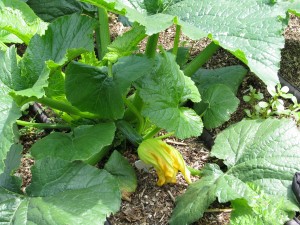
The First Zucchini... uh-oh! 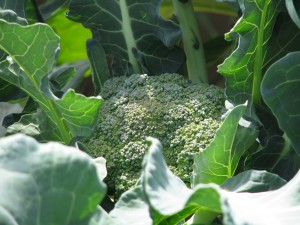
A Hidden Broccoli Head -
Ashland, OR and the Sacramento River
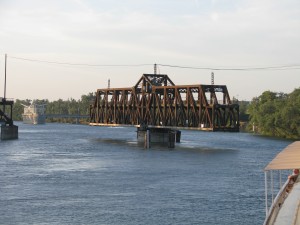
- Rotating Tracks
My daughter and I are returning from middle Oregon to San Diego in steps. Last night we stayed in a wonderful bed and breakfast, Country Willows, in Ashland, OR. http://www.countrywillowsinn.com/.
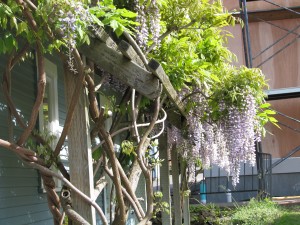
Wisteria adorns the porch We did a little walking around looking at the wonderful poppies that grew in almost every yard,

Poppies and then went downtown to see a modernized version of Love’s Labours Lost in the outdoor Elizabethan theatre. Ashland is the home of the Oregon Shakespeare festival, as well as being a college town, so there were plenty of young people doing avante-garde things in the streets. Every night there is a free performance on the grounds between the three Shakespearean theatres. We listened to a talented group play Eastern European tunes before being seated for the play. Prior to this we ate at Green Leaf restaurant, which overlooks the waterway and has superb local and sustainably raised food, as well as many vegetarian dishes. Oh, yum. What a good meal!
After the play we drove back to the bed and breakfast, and it was nearly midnight, so I didn’t blog and I’m sorry. In the morning Daniel, who is the manager and chef created a wonderful breakfast served by one of the owners. We had sweet potato biscuits, orange and cherry juice layered in chilled glasses, orange and tangerine sections drizzled with raspberry coulis, poached eggs in tomato and cilantro sauce with black beans and fresh local greens, and decaf tea. It was tasty, nutritious, beautiful and creative to look at, and served in a wonderfully decorated room overlooking a pink flowering dogwood. Wonderful!

Country Willows Bed and Breakfast Today we drove to Sacramento and are staying on the Delta King riverboat on the Sacramento River http://www.deltaking.com/.

Historic Riverboat Warning 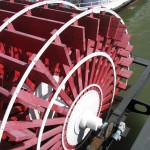
- Paddlewheel
It is an historic real paddlewheeler which is now stationary. We strolled old town Sacramento which is all tourist shops in old storefronts, including about five candy stores.

Old Sacramento against the new Miranda spotted a train museum and we went in about half an hour before closing. I was expecting model trains and photographs… oh, how I wish that we had more time! The museum had full historic trains parked in it, along with life-sized displays surrounding them showing their point in history. The docents were incredibly knowledgeable and eager to share their knowledge, even though it was the end of the day. If you ever come this way, spend about two hours at the Sacramento Train Museum http://www.csrmf.org/. They even have a sleeper car that you may walk thorough that is rocks like when it was on the rails. Even people who aren’t big on trains will be awestruck by what they’ve accomplished here. None of my photographs from inside came out, and we were rushing through so I didn’t take many.
Afterwards we ate at one of the small shops then spent time outside of our stateroom watching the two bridges move for tall boats. The drive-across bridge raised and lowered, sounding a loud horn to let cars, pedestrians and bicyclists know that the bridge was going up.
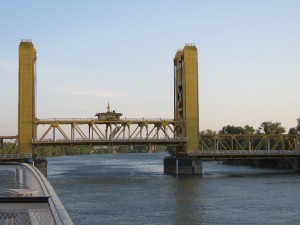
The Bridge about to rise 
The Hornblower River Cruise slides under the bridge On the other side of our boat there is a train bridge that spins to allow a boat through.

Watching trains cross the trestle 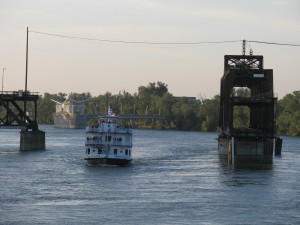
The Train Testle Swivels Very, very cool. We watched trains go past as well.
From the other side of the river we could hear the crowd shouting through a ballgame, and occasionally there were rowdies shouting or playing music at speaker-cracking volume from their boats as they cruised past (if they do it in cars, they do it on boats). It was pretty quiet for a Friday night. The stateroom was very comfortable; we made tea and drank it at the small table outside our room and watched the swallows swoop after moths in the sunset.
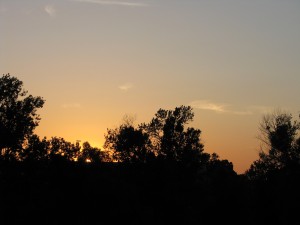
Sunset Tomorrow is an eight-hour drive home. It was a fun week, traveling solo, then celebrating my daughter’s finishing her second year at OSU with some new mini-adventures. Fortunately, I always love being home, too. Travel creates great perspective on homelife. I love both.
-
A Thousand Miles
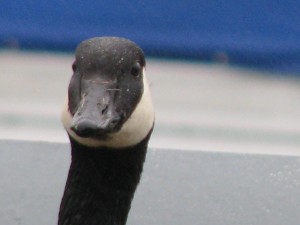
Honk if you love geese! I intended to write yesterday, but the place where I stopped didn’t have Internet. Sorry! I left Fallbrook just before daybreak on Monday.
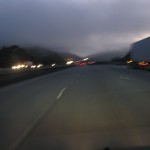
Five o'clock AM on Hwy 15 I saw beautiful clouds at dawn.

Dawn-kissed clouds I also saw a lot of car butts.
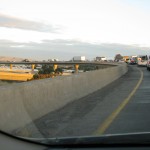
An hour inching behind car butts Ah, the roads to Los Angeles. I’m a seasoned car traveler now. I have my backpack next to me, one audiobook loaded with a couple of spares and some music CDs within easy reach, as are snacks, a water bottle, tissues, and my camera with the viewfinder turned out. I try to snap photos without taking my eyes off the road. Some photos turn out not so good.
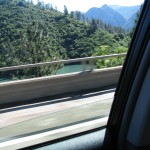
Almost got it... Some turn out okay.
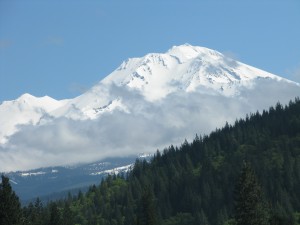
Mt. Shasta Stopping only twice for gas, I was on my eleventh hour driving when I encountered rain with low visibility and decided that enough was enough. I passed by many spots advertising places to stay; some I would have turned in for but was blocked by one of the ever-present trucks kicking up rain spray and edging precariously close to the middle line on the twisty, narrow stretch of I-5. I really wanted something with a nice view with a restaurant close by, but I was willing to stop for almost anything by that point. I saw a sign and pulled off and over I-5 through tall pines looming in the rain. Then suddenly I found myself looking at Shasta Lake and the Bridge Bay Lodge! I started to laugh! If I had planned the stop it couldn’t have been better!

Beautiful in the Rain They had a room… in fact, it was nearly empty, and a restaurant that wasn’t cheap but did offer vegetarian entrees. The rain set in, but I walked around a little before heading to bed. I made sure that I didn’t leave any food outside the door!
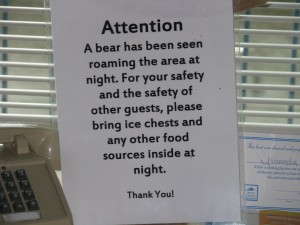
I'm not in San Diego anymore.... I watched a little television… I don’t have TV at home and haven’t watched it in about 16 years… and was shocked at how absolutely stupid and time-wasting the shows were. And I was switching between the History Channel, A&E, and National Geographic! I was horrified, and turned it off.
I awoke to a clear warm dawn, and what had looked like this the night before:
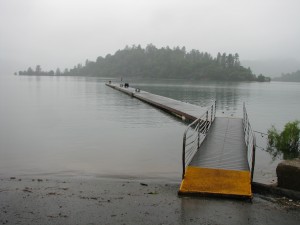
Dock in the rainy dusk now looked like this:
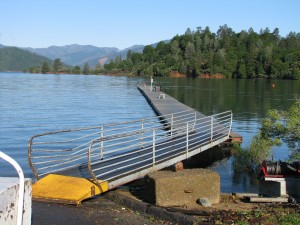
Dock in the morning And like this:
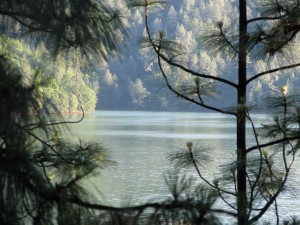
Dawn on Lake Shasta 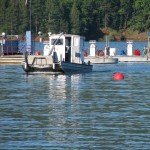
Out on the Lake 
Family outing 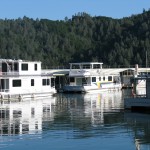
Houseboats I was so thrilled. I’m sure the place is a zoo on the weekends, and I had a quiet night only because I had no neighbors, but it was food for the soul.

Flotilla of Canada Geese After having food for the tummy (breakfast is my favorite meal!)
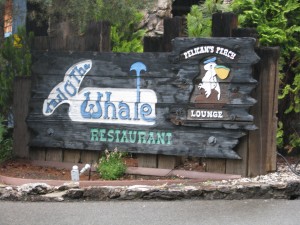
- I love a silly name
off I went for the last four hundred miles to Corvallis, through absolutely gorgeous scenery. Tomorrow I give my hinder a break and don’t plan to do much driving, but help my daughter move out of her dorm in the evening after her last final and then head for home on Thursday.
I very much enjoy being out on my own. Although I planned the way back with my daughter with reservations for a bed and breakfast and tickets to a Shakespearean play in Ashland, OR the first night, and on a restored ferryboat hotel on the Sacramento river the second night, I like the spontenaity and roll of the dice of just driving unplanned. If I had no animals at home, I’d do what I had asked friends to do the summer after high school graduation (they all had summer jobs!) and drive the USA. I love the freedom. I love the thought that no one knows where I am. I love the fact that I could end up sleeping in the car or in a dive if my luck ran out, or in a wonderful place such as I just found myself at Shasta Lake. As long as I can share it with all of you!
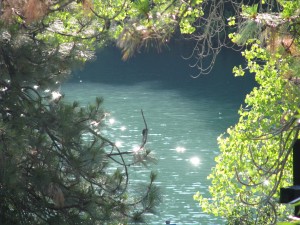
Sparkling Water -
Until Next Week….
I’m about to do the drive from Fallbrook, CA (in San Diego County) to Corvallis, OR again. Almost exactly a thousand miles. I’ll be back home in six days (I’ll be blogging as I go, though!). However, the day before a trip I get a little crazy. I whip myself into a cleaning and organizing fury. Part of it is that I like to come back to a clean house. Part of it is that I have a lot of animals and I want to make sure that they are all as set up as possible with food, water and clean bedding, even though they’ll be taken care of on a daily basis while I’m gone. Part of it is that I get a kick out of multi-tasking and coordinating, and I burn off a lot of pre-travel worry this way. I shop and stock up on animal food, I do laundry, hauling wet sheets and rugs out to the clothes line and back in again. I cook, take out recyclables and trash, pack and blog. I soak and scrub cat and dog dishes, I sweep the walkway (why? I don’t know. It will be gunky by the time I get back), I clean out the last of the honey that is dripping from crushed comb and give the bucket to the bees to clean up. (Straw on the bottom keeps the bees from becoming stuck in the honey and drowning.)

Bees cleaning up honey I water everything. I wash the dogs and their bedding. I leave unnecessary notes.
It is wise to keep out of my way on the day before a trip.
Work will go on in the yard while I’m away. I’ll tune in next week to find out the answers for….
Will the lower pond be filled, and not look like green tea?
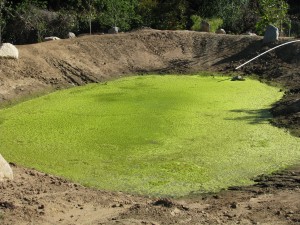
Pond algae Will these palm trunks become a bridge?
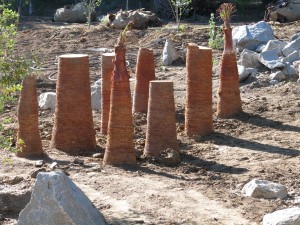
Bridge pilons Will these fancy new stairs made from cement chunks lead to something?

New Steps Will the jasmine hedge still be blooming?
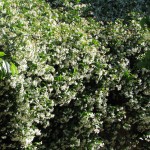
Jasmine Hedge Will the giant sunflower ever look up? Will the vining vegetables take over the property?
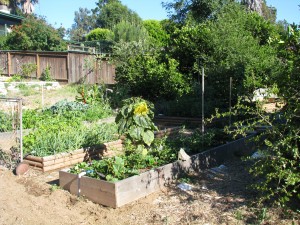
Garden Growing Will whatever is eating the stairs leave any to walk on?
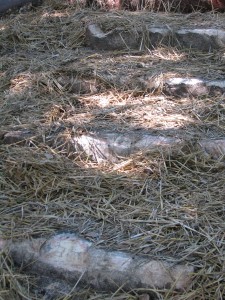
Chewed Steps Will the subterranean irrigation lines be buried?

Irrigation lines Will the kumquats ever get cuter? (Impossible. Too fun a name, to say and to spell. Go ahead, say it: “Kumquat, kumquat, kumquat.” See? Cute name for cute fruit.)

Kumquats These and other questions will (in all probability) be answered next week. Stay tuned for the answers… same bat time, same bat station.
-
Natural Cleaning Products: Vinegar

Vinegar Cleans Glass Beautifully I’m on a personal crusade to remove all non-environmentally friendly cleaning products from my home…. life… universe… well, I’ll start at home anyway. Not only does my house utilize a septic tank and I’m not supposed to have scrubbing bubbles living a dark life beneath my yard, but harsh chemicals are bad to breathe, bad to have eat through the skin on my fingers, and bad for the environment and water. So how on earth did humans clean prior to the chemical revolution? With what they had around them, of course. They usually had wine, or some sort of fermenting juice around, and after the fermentation was gone they had vinegar. Anything that smelled that strongly had to clean well, and it actually did and does. Undistilled vinegar, or acetic acid, has antiseptic and antibacterial properties that were written about by Hippocrates, the father of medicine.
There has been a foodie revolution with artisanal vinegars, and now people who rarely cook anything but a TV dinner know what Balsamic or wine vinegar is. If you’ve ever been to England you’ll know about shaking malt vinegar onto chips (French fries), which is absolutely delicious, by the way. But the vinegars found in grandma’s pantry were cider vinegar and white vinegar.
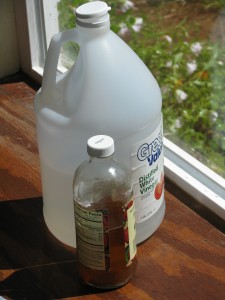
White and Cider Vinegar Cider vinegar has an old-fashioned flavor and is used in cooking, especially Eastern European foods. There was a huge health fad when I was little about the benefits of drinking apple cider vinegar, and people still swear by it. My mom gave us a glass of warm water with cider vinegar and honey in it to drink with our dinner. I got to really like the taste. Undistilled cider vinegar has a floating mass in the bottle; that is called the ‘mother’, and it is part of the fermentation process, and can be removed and used to help ferment other vinegars. People don’t like that mass, so they invented white vinegar which has little of the nutrition that cider vinegar has.
White vinegar is made from fermented grains, mostly corn, and this is the product that is now used in cleaning because it won’t leave a brown mark and is less expensive than other vinegars. There are hundreds of uses for vinegar, besides setting color when dying eggs. What vinegar is really valuable for here in Southern California with its mineral-heavy water, is to clean out those mineral deposits from machines and glassware. Glass vases that had acquired rings inside from holding tap water, which didn’t come out with a brush and soap, became clear and beautiful when I filled them with vinegar and water and let them soak for an hour. The same for a crystal decoration that is filled with water and hung to catch the light, filling the room with prisms.

Crystal Clear It had mineral buildup and was ugly (now I use distilled water in it!), and after a vinegar and water soaking, and a little nudging with a long, skinny brush, it is beautiful again.
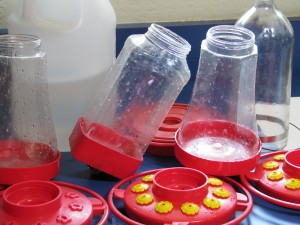
Cleaning Bacteria from Hummingbird Feeders Hummingbird feeders must be cleaned regularly because the black mold that grows on the feeder holes will infect the hummingbirds and eventually kill them. I’ve always used a bleach solution to soak them. No more! I use hot water and vinegar to soak, then use straight vinegar and a brush to kill any germs around the bases. I’ve noticed that besides not being gassed with the chlorine bleach fumes, that the feeders stay clean just as long as they had when I used bleach to kill the germs.
I was talking with a friend about dishwashers and how glasses weren’t getting clean and the dishwasher just wasn’t performing well anymore. She passed on the tip from another friend to dump a whole gallon of white vinegar into the machine and let it run. The vinegar loosens up all that mineral yuck that clogs up the works. It works in drains, too.
Vinegar cuts through grease and grime, like that scary fuzzy layer on the top of your refrigerator, or that grease build-up over the kitchen range. I switched to cleaning windows with vinegar water and newspaper, and have had great success.
Combined with the alkaline baking soda (bicarbonate of soda), vinegar fizzes and was what made your fifth-grade Science Fair volcano erupt, or the toy submarine skim through the pool (I loved mine!). Mixed with some dish soap, these three ingredients work well to remove stains, such as those in the shower or on counters. Use the paste on an old toothbrush to clean up grout.
Other uses for vinegar include as a hair rinse, to make hair supple and shiny; in water when boiling eggs so they won’t crack and they’ll peel more easily (give them a cold water bath right after cooking, and try not to use very fresh eggs, which are very hard to peel after boiling). Run it through the coffee maker, or in the bottom of a kettle to dislodge the chunks of minerals that stick to the insides. Go on the Internet and search for lots of ideas on how to use vinegar in your routine. Vinegar is safe, efficient, natural, and its smell isn’t any worse than that of chemicl cleaners, and a lot easier on your lungs.
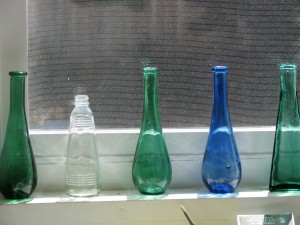
It dissolves hard water stains -
What is a Weed, Anyway?
Weeds are plants that grow where you don’t want them to. It is a label given with purely human whim that often interferes with nature taking care of its animals and soil. Unless you are removing invasive species, weeds have a purpose and can not only be useful medicinally, but also are indicator plants of how healthy your soil is.
In the February 1989 issue of Organic Gardening, I wrote an article called Selective Weeding. In it I described how weeds with deep tap roots not only break up the soil, but are nutrient ‘miners’; they take up minerals from down deep in the earth, send them up to their leaves, and then leave them on the soil surface when the leaves die, which improves the quality of the topsoil for other plants to thrive. Around here, wild radish is the most notable weed that does this although it is invasive, but it isn’t the only one.
Other weeds make good groundcover, such as purslane. Purslane needs fertile soil to thrive, so when you see it, you know there is good soil. It is also edible and a good source of calcium, iron and Omega-3 fatty acids…. a real plus for we vegetarians who don’t eat fish. Lamb’s quarters also grows in highly fertile ground and is very edible. Red clover also loves fertile soil and it’s importance to the pollinator insects is vital. Clover roots set nitrogen in the soil and is often used as a cover crop.
Plantain (Plantago major and not the banana) is naturalized throughout North America and I guarantee that everyone has seen it whether they know it or not. The variety with rounded leaves in a rosette is a common lawn weed, and the variety with long, lanceolet leaves with long veins that grows by waterways is much larger. Why streams and lawns? It thrives in soil that has low fertility and high ratio of water. Plantain makes an excellent salve for stinging nettle rash, insect stings and some say poison oak rash. If you brush against nettle while hiking you’ll know right away because it releases chemicals into your skin that burns for awhile and then dissipates. Look around for plantain, break a leaf and roll it between your fingers till it releases the juice and apply to the site.
Nettle is another great plant even though it stings in self-defense. The chemicals that sting are water-soluable, so if you pick young nettle and soak it or cook it like spinach, you have a green that is very high in Vitamin K, protein, calcium, maganese and potassium. Nettle soup is commonly served in other countries. Nettle is an indicator plant of soil that is high in nitrogen and phosphate, which explains why it often grows around abandoned buildings and farms where there has been animal and human waste. Nettle is the host plant for many butterfly species as well.
Poison oak has a place in our native forests as well. It is a plant which happens to give off a chemical that humans find irritating. It produces berries that birds rely on, it provides shade in the understory to hold in moisture and give safe harbor to many animals, it is beautiful with its bright green spring growth and dark red autumn shades. The entire plant produces an oil that gives most people a rash, which doesn’t begin to irritate the skin for several days. Thinking about the substance being an oil will help you consider how to deal with it. If you or your dog brush it, the oil will transfer to your clothes, skin or your dog’s fur (another great reason why you shouldn’t let your dog run off-leash in natural areas!), and transfer again when it is touched. If burned, the toxicity is increased and you can inhale the fumes and become critically ill. If you think that you’ve brushed against poison oak, wash your clothes separately from the rest of the laundry and wash your skin well. There are many products on the market which help dissolve the oil, such as Technu, which is a wash for just after you’ve touched the plant. On hot days the plant’s oils carry in the air so people who are very sensitive should avoid poison oak habitat in the summer.
Weeds that indicate compacted soil, which is low in oxygen, are bindweed (looks like a small white or pink morning glory), quackgrass and chicory with its tall blue flower. Chicory’s deep taproot mines the minerals and breaks up the soil, and bindweed covers the soil providing some shade and protection against more compaction and dropping leaves over an extended area for mulch. Quackgrass secretes a chemical that supresses other plant growth as it travels via rhizome, breaking up the soil surface and carpeting it for protection.
Dandelions, a weed of childhood fantasy, of back-country wine, of spring tonic greens, are happy little plants that lawn owners ruthlessly kill. They grow in many soils, but are indicators of acidic soil. Henbane is a sign of alkaline soil.
Whether you keep your weeds, selectively weed, or eradicate them all, you should at least learn what they have to tell you. A good list of California weeds is at http://www.ipm.ucdavis.edu/PMG/weeds_intro.html .. An extremely valuable book that I have used so often when conducting hikes (and there is always a little girl that asks what every little plant is along the way), is Roadside Plants of Southern California by Thomas Belzer. It has photographs, descriptions and whether the plant is native or not. Another book is the Natural History of Vacant Lots by Matthew Vessel et al. These are wonderful guides for all the plants that fall between the cracks of most plant ID guides.
Just remember that plants communicate to you, and each have a purpose to fulfill. Whether it be as a mineral miner, a canopy or shade plant, a pollinator and food source, a nitrogen-fixer, a soil breaker, a mulch plant, each is doing something to help build earth fertility. Plants that are non-native take the place of the ones that are native and important to an area and its habitat, supplanting perhaps a plant that is the host for a particular butterfly. Be enlightened when doing yardwork. Feel free, though, to eradicate any Bermuda grass that you see, because it is a weed against which I have a personal vendetta! Happy gardening.
- Gardening adventures, Permaculture and Edible Forest Gardening Adventures, Photos, Vegetables, Vegetarian
“Who’s That Chewing on MY Step?” or, Garden Update June 1

Hidden Treasure Many of the steps that were created out of the Washingtonia palm trees are doing just fine. However, there are some that were squared off with a chainsaw and their whiteness and neatness really stood out on the hillside. They stood out a little too well, apparently, because something is gnawing away at them!

Chew Marks It can be either rats or bunnies, and I’ve only found bunny scat in the straw. In defense of my nice stairs, I’ve sprayed them with Bitter Apple, which is a product used to spray on doctored pets to keep them from licking or chewing on bandages.

Heart of Palm I spread the straw over the steps again. I’ll see tomorrow what has happened.

Cherries! Other finds around the garden are my first (and probably only) two cherries! Cherries are not known to grow in our Zone 10 climate; however, there are a few hybrids that are supposed to be ‘low chill’. Cherries are one of my favorite fruits, so I’m thrilled that this tree is giving it a go.

Magnolia The magnolia trees are blooming, and a transplanted Blue Girl rose is much happier in the Blue Garden, which is also the Bee Garden.
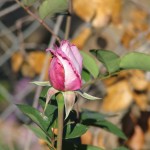
Blue Girl A vegetable garden is a stern taskmaster. After all that waiting at the beginning of the year, plants are flourishing. This is the best garden I’ve ever had. After all that work building raised beds, lining them with aviary wire and filling them with good soil, it had better be good!

Last Two Beds I have two more raised beds to level, line and fill. I have more pumpkin seedlings up and I need the beds ready to plant. I can’t believe it is June first already.
Today I put up strings for the pickling cucumbers and the pinto beans to climb on. Those two beds, which are the newest and which have the least amended soil, are still doing very well.
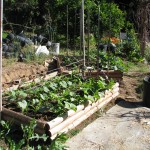
Strung Up I also staked the three yellow tomato plants, and three ‘soup bean’ plants, as well as planting more of those beans by more stakes.
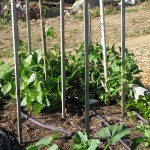
Bean and Tomato Stakes I had no idea that fava beans grew up! I mean, the beans don’t dangle like other beans do, but grow straight up, like huge fat caterpillars. Crazy! I also read where the young leaves are tasty so I tried one… then I ate several. They are much more flavorful than pea shoots.
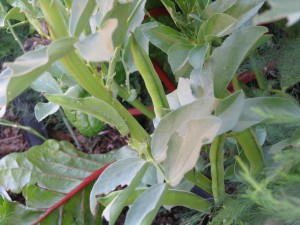
Fava Beans Scarlet runner beans grow down, but are slightly fuzzy, which is a little creepy. They can be eaten young, or let dry on the vine.
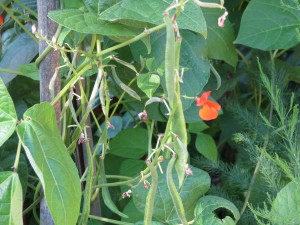
Runner Beans are Fuzzy I planted a white and yellow sweet corn, now that the popcorn is well up. I’ll wait a month to plant the full yellow sweet corn, not only to stagger harvests but because corn will cross-pollinate. Meanwhile, I have my trusted rubber snake watching the bed.

Corn snake This package contains carrots of various colors, so I planted some just for fun. I’ve heard that some of the darker colored carrots aren’t that sweet, but I want proof.
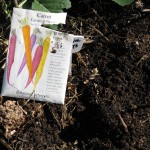
Crazy Carrots When spacing seeds for corn or other plants which need room, use your trowel as a guide. It is about a foot long, and corn needs to be a foot by two feet apart. Plant corn in blocks so that they can pollinate better; the pollen will drift off the tassels onto the silk of the neighboring corn.
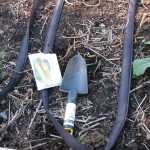
Trowel Ruler I also planted cinnamon basil, which has the most wonderful aroma. You can use it in cooking, especially for sweets, but I just let it go to bloom, then cut some and set them in water in the house for the perfume.

Cinnamon Basil This bed contains garlic, shallots, bush beans, tomatoes and basil, all of which are contending for sunlight. The bed receives sun all day and the rows are planted south to north, so the plants won’t shade each other for any length of time.

Full Bed The sunflower that was pouting last week has trouble staying awake this week. Her heavy head just can’t be lifted. Lesser goldfinches love to eat the leaves, leaving them skeletonized.
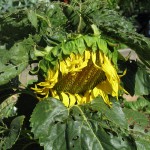
Heavy Head Of course, the best thing that is growing in my garden is this volunteer melon, which appeared under the peas I just cut out, and now that it has found the light, so to speak, it has grown one and a half feet long and going strong, and has a flower! But what is it? A remnant from melons I planted in the past? Seeds from the compost from melons I have eaten? There’s nothing like a mystery!
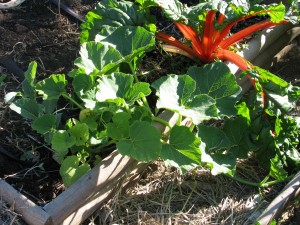
Volunteer Melon -
Popovers (and a Pumpkin Turkey Cake Story)
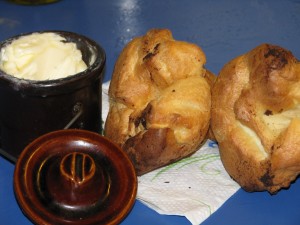
Serve Popovers Hot Popovers are usually thought of as a type of roll to make with roast beef, using the suet as the shortening and using the popovers to sop up the beef ‘juices’. In the immortal words of Penfold of the Danger Mouse cartoons, “Oh, ick!” I’ve made vegetarian popovers for many years and they are not only extremely easy to make, but fun to eat. My recipe contains dairy products, but any vegan cook could whip some up with rice or soy milk.
Popovers are made from a simple batter which relies on very high heat and steam to make them puff. There are two baking temperatures, the first is high to create steam for the lift-off, so to speak, and the second is moderate for the cooking through to the tender insides. For the last few minutes of baking you should stick each popover with a fork to release the steam, otherwise they’ll end up soggy.
You have to eat popovers right away, with as much butter as your conscience will allow. Or use them to sop up vegetarian gravy. You can also add cinnamon or nutmeg into the batter and serve them for breakfast.
For years I made popovers in oven-proof custard dishes. They didn’t rise as high and were wider than normal, but me and my children managed to choke them down pretty well.

Oven-proof custard cup Then I bought myself a real popover pan. I’m a real sucker for shaped baking pans. I think I could keep Nordicware in business if I didn’t control myself.
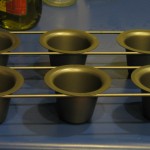
Popover Pan I don’t even bake very much anymore, but I do love my castle bundt pan, or turkey cake pan that my daughter bought me (there is a story there. I’ll tell it later*.) There are worse vices. I think. The popovers in the popover pan look terrific and are very impressive, but they eat just the same way that the custard cup ones did. So, go make some popovers! What are you waiting for?
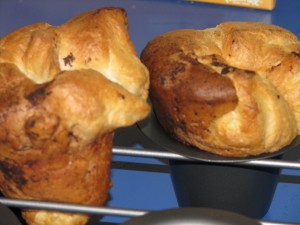
All popped and waiting for butter! PopoversAuthor: Diane KennedyRecipe type: BreadPrep time:Cook time:Total time:Serves: 6Popovers without the suet, for lacto-ovo vegetarians and the world!Ingredients- 1 tablespoon butter or vegetable oil
- 2 eggs
- 1 cup milk
- 1 tablespoon vegetable oil
- 1 cup all-purpose flour
- ¼ teaspoon freshly ground pepper (opt.)
- ½ teaspoon ground cinnamon or nutmeg if you are making breakfast popovers)
Instructions- Heat oven to 400 degrees F.
- Put ½ teaspoon of butter or oil in each of six 6-ounce oven-proof custard cups or in each cup of a popover pan. Coat the bottom and sides.
- Place custard cups on a cookie sheet, if using.
- In a blender, mixer, or in a bowl with a wire whisk, beat eggs, milk and oil until combined. Beat to blend; don't incorporate too much air into the batter.
- Add flour (and spice if using) and combine until smooth.
- Divide batter between prepared cups; each should be half full.
- Bake for twenty minutes in 400 degree oven, then reduce the heat to 350 and bake fifteen minutes more.
- Turn oven off.
- With the tip of a knife or a fork, prick the tops of the popovers and allow them to stay in the oven for about five minutes more. Popovers should be firm and crisp on the outside, and tender on the inside.
- Remove popovers from oven; turn out of pan or cups and serve immediately.
- Makes six.
* Okay, so here’s the turkey cake story. My daughter gave me this fabulous turkey cake mold last year. I decided to have Thanksgiving early with my son, then fly to her university to have Thanksgiving with her. I made most of the meal and packed it up in my carry-on (no liquids!). After some debate with myself, I caved in to my sillier side and baked a pumpkin cake in the turkey pan and sandwiched the sides together with buttercream frosting. It looked perfect! I wrapped that sucker up in lots of plastic wrap, stuck in on top in my carry-on, and headed for Carlsbad airport.Flying out of a small airport is the only way to go. Small lines, easy parking, and a not-so-hostile security. When my carry-on went through the X-ray machine, I wasn’t surprised when they pulled it off and called me over. I explained to the very nice female officer that the dark blob in my bag was a pumpkin cake shaped like a turkey. She said that they’d have to check it again, which they did. She and another security officer had a good laugh at the image and when she brought it back to me she said that in profile it looked exactly like a small real turkey on the screen. Then much more seriously she asked if I was going to change planes on my trip. When I told her that I was, in Los Angeles, she quickly advised, “Don’t go out of the security area there!” I don’t think the Los Angeles airport security force, on a high-risk day-before Thanksgiving holiday, would feel so friendly towards my turkey cake.
-
Well, Well, Well!

A Big Rig The battle for the water looks as if it is slowly being won. Today a 100 foot deep eight inch hole was drilled behind my pond. I feel sorry for the earth, like a big mosquito has stabbed into it’s bedrock.Fain drillers had quite a time maneurvering their truck in backwards. A portion of the fence had to be removed for the ginormous truck to back in. Then it had to move back and forth by inches to get around all the plants and rocks.
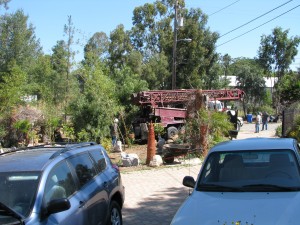
Backing through the fence 
Backing down the property Finally it was in place, and they balanced the truck with lifts so that the back end was off the ground!

Leveling the truck Raising the drill bit was very impressive. It is so tall!

So tall! As they drilled, up came slurry of water, clay, and decomposed granite.

Water and slurry They drilled 100 feet today, and and found water that is moving at about fifteen gallons per minute.

Adding bits For the drip system, I only need a mere five. However, I don’t know what may happen, if I may want to hook the house water up to the well some year or something. If I have them drill more deeply now since thieir truck is in the yard, the well might have a better rate of flow, better water, and possibly a more reliable supply.

Changing parts What I have might be just fine, and there is no guarantee that anything will improve with more drilling. I’ll make my descision over the weekend. On Tuesday they’ll drill some more if I want it, then put in a casing, gravel around the casing, cement the top, and then we can lower the pump and get well water! Cross my fingers!
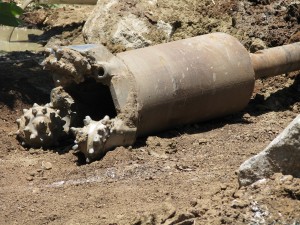
Mean-looking grinding bit

